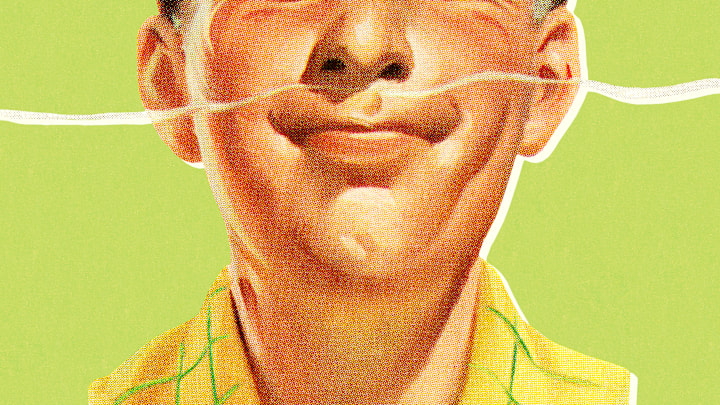Nothing can trigger a memory so unexpectedly as an aroma. Clove oil immediately transports you to the dentist’s office. Crayola crayons take you back to elementary school. But some fragrances are being phased out of existence thanks to technology and safety regulations. How many of these do you miss?
Spirit Duplicators
Spirit duplicators, also known as Ditto machines, were created by Wilhelm Ritzerfeld in Berlin in the 1920s. For kids of a certain era, it was an olfactory treat whenever the teacher passed out fresh-off-the-machine purple print ditto sheets to the class. Virtually every student immediately held the page to their face and inhaled deeply. There was something so pleasing about the aroma that emanated from the printing fluid—a methanol-based mixture. Ditto machines—and the delightful aroma they created—are now obsolete.
Burning Leaves
A common indicator that autumn was winding down and winter would soon be here was the crisp air filled with the smell of burning leaves. The breeze had a bite to it by the time October rolled around and the ground was sometimes coated with a fine layer of frost, but the smoke from the pile of leaves everyone on the block seemed to burn somehow smelled warm and comforting.
Pollution concerns caused municipalities in the U.S. to enact open burning bans beginning in the late 1960s, and today residents are encouraged to either rake and bag their leaves or use them for mulch. Of course, compost piles do have their own aroma, but it’s not particularly enticing.
Diesel Exhaust
City buses and semi-trucks don’t smell quite like they used to when they accelerate on a cold morning. There are a lot of folks that actually enjoyed the old school smell of the black exhaust these vehicles used to belch. But reductions in the sulfur content of diesel fuel along with selective catalytic reduction gives today’s diesel burners more of a cat uriney type of aroma.
Freshly-opened Polaroid Film
Polaroid ceased production of their instant film in 2008. The foil packs used to produce a sweetish chemical odor when they were first torn open. It was, in fact, the official “smell” of photography for a lot of kids whose first camera was a Polaroid. These days, instant film is making a comeback—and so is that instant film smell—but it will never be as ubiquitous as it once was.
Magic Markers

The classic glass bottle-bodied Magic Marker was first marketed in 1952, and until the early 1990s, the ink formula included things like Toluene and Xylene, two solvents which not only had a distinctive (and not unpleasant) odor, but which also contained intoxicating properties when inhaled. Today’s permanent markers get their color from less fragrant alcohol-based inks.
Bubble Gum Cards
Topps stopped including a stick of stiff, hard-to-chew bubble gum in their trading cards in the early 1990s, when more collectors than kids were buying the product and complaining about the gum sticking to and ruining the card it was next to. (As one newspaper put it, “The adult dweebs who have taken the childhood out of the previously carefree activity of collecting baseball cards have just won their ultimate dweebish victory.”) So kids today are getting mint-condition cards for their money, but they’re missing out on that distinctive bubble gum smell that wafted from the package when it was opened (and from the cards when they were brand new).
Cap Guns
Even if you didn’t have a toy gun handy, it was easy enough (if a bit dangerous) to “shoot off” caps by striking them with a hammer or even a rock. The gunpowder/sulfur smell of an exploded cap is another aroma that immediately propels many minds to summer days spent playing cops and robbers.
Old New Car Smell
That aroma we smell today upon delivery of a brand new set of wheels is very different from the new car smell a long time ago. A lot of that smell comes from off-gassing synthetic materials, plastics and chemical additives that are used in modern vehicles. In 1960, the average American-made car contained around 20 pounds of plastics; in 2021 that was estimated to be 411 pounds. And this can make the smells highly variable. In 2003, a writer with Car and Driver took a sommelier around to sniff cars and found that “Bentleys and Rolls-Royces smell dizzyingly like leather. Less expensive cars smell more like a new shower curtain or newly installed wall-to-wall carpeting.” But it’s probably best to avoid a repeat of the experiment—while one 2007 study found no cause for concern from the volatile organic compounds, other studies have indicated there might be a health risk.
Vacuum Tube Electronics

Old TVs and radios that were filled with tubes instead of transistors emitted a “warm” or hot engine smell as they heated up. If you weren’t particularly fastidious with the feather duster, a fine layer of dust would accumulate on the equipment inside and add a slight burning aroma to the mix. The old movie and film projectors used in schools had a similar smell once the light bulb inside had been burning for a while.
Telephone Book
Thanks to Google, very few people let their fingers walk through the Yellow Pages anymore when they’re searching for a telephone number or address. Years ago, almost every home and office had a small stack of thick telephone directories (for example, in the Metro Detroit area there were separate books for Detroit, East Area, North Woodward, and Downriver) that were referred to regularly. The inexpensive pulp paper plus the ink and glue in the binding gave the giant tomes a much mustier, paper-y odor than a standard paperback novel.
Chalk Dust

Much like cafeteria food and library paste, chalk dust simply smelled like school. With so many classrooms using whiteboards, chalkboard ledges with piles of white powder on them are becoming extinct.
Discover More Stories About Nostalgia:
A version of this story ran in 2018; it has been updated for 2025.
